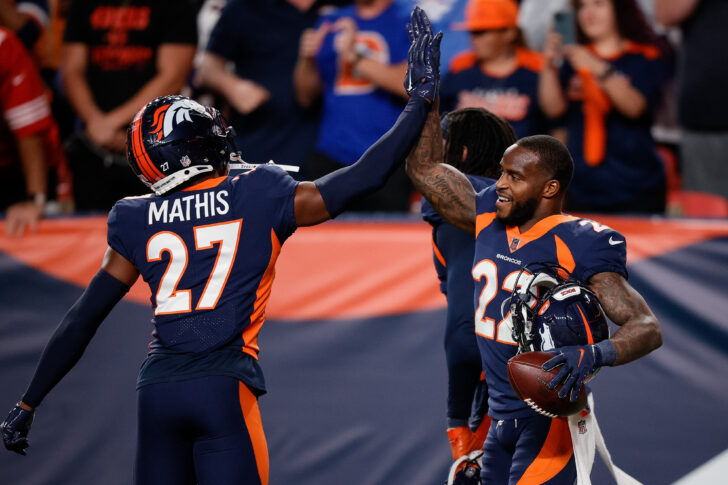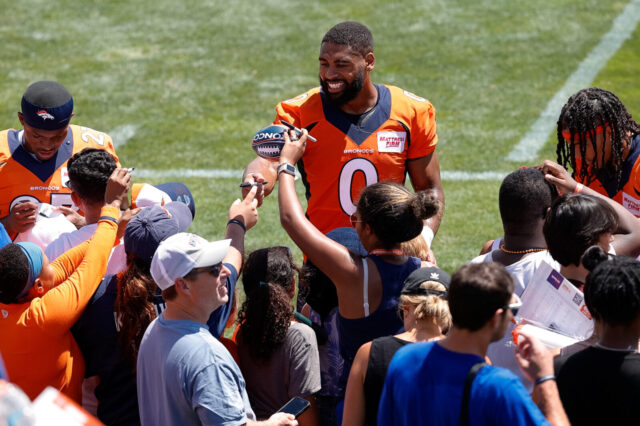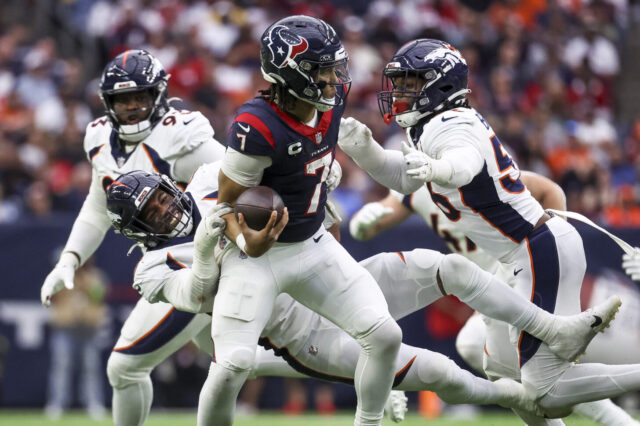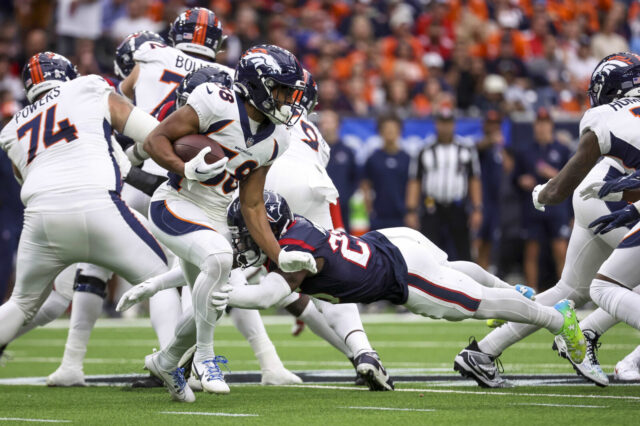We’ve now seen one full season of how George Paton’s second NFL draft for the Denver Broncos has performed, making now an excellent time to review all of those selections and how they performed in year one.
We graded the picks based on our initial reactions back in April, but how did the players actually perform?
It’s safe to say this year’s class isn’t as good as 2021’s, but just how much worse is it? Let’s look.
Round 2. Pick 64: Nik Bonitto, EDGE
Injuries and the Bradley Chubb trade forced Nik Bonitto into a much larger role than he was expected to have. He quickly rose from the team’s fifth edge rusher on the depth chart to being No. 3 by season’s end, and was solid in that playing time.
Many of his pre-draft concerns reared their head, as he failed to make much of a positive impact in the run game, and he also struggled to win his blocks once he was engaged by the offensive tackle. Bonitto has always won with a lightning-fast first step and bend, and when he’s forced out of that box, he didn’t show much ability to pivot and win reps in different ways.
That said, although you would’ve liked to see some more growth from his college tape, what he did well carried over pretty smoothly to the NFL game, which was a sizable concern, considering it’s much harder to beat NFL tackles with pure athleticism and reactive quickness than it is Big 12 tackles.
Still, Bonitto finished the season with solid production, outside of the sack column. His sack count of 1.5 is unimpressive and is tied for 24th among all rookies, but pressures and pass-rush wins are a better indicator of pass-rushing success, and in those departments, Bonitto’s play is a lot more appealing. Among rookie edge rushers, Bonitto finished eighth in pressures (19), seventh in pass-rush productivity (a metric created by Pro Football Focus to measure a pass-rusher’s per-snap impact), and tied Aidan Hutchinson, the second overall pick, in pass-rush win rate (14.6%).
To live up to his NFL draft status and become more than a rotational figure, Bonitto will have to fill the sizable gaps in his game, but there’s some exciting upside he possesses as a pass rusher.
Original Grade: B
Year One Grade: B
Round 3. Pick 80: Greg Dulcich, TE
By any metric you use to measure tight end play, Greg Dulcich had one of the best rookie seasons, from a per-game perspective, that we’ve seen at the position, despite facing far more adversity than most.
He missed almost the entirety of his first off-season program and first five weeks of the season with a hamstring injury, and then finished the season on injured reserve, while playing in the NFL’s least functional offense, buried on a depth chart with plenty of established veterans, and still managed to find success.
From his first game, Dulcich became an impactful receiver, with his preternatural understanding of how to manipulate leverage and space to his advantage. He already shows a football IQ beyond his years when it comes to taking what the defense gives him to create separation and easy reception opportunities. Pair that with his fluidity after the catch, and pillow-soft hands, and you’ve got an extremely appealing receiving tight end.
Among all rookie tight ends in NFL history, Dulcich now has the 13th-most yards per game (41.1) and the 12th-most receptions per game (3.3) ever by a rookie tight end. The future is bright there.
The big gap in Dulcich’s game was as a blocker, but over the course of his rookie season, he showed considerable growth in that aspect of his game, particularly when blocking defensive backs and smaller linebackers out in space.
Plus, while Dulcich is a little deficient here, that’s not a product of mentality or temperament. He won’t shy away from contact, but he arrived at UCLA as a wide receiver, and that’s still somewhat present in his frame, making him a less powerful blocker than most tight ends.
Overall, at one of the slower-to-develop positions in the sport, Dulcich immediately cemented himself as one of the most promising weapons on the offense and should be a focal point of the 2023 attack, despite having every excuse imaginable at his disposal.
Original Grade: B-
Year One Grade: A
Round 4. Pick 115: Damarri Mathis, CB
As a remarkably talented, but a little underdeveloped, cornerback, getting the opportunity to sit for a season and learn under Patrick Surtain II, Ronald Darby, and K’Waun Williams seems like a pretty sweet deal. Unfortunately, that cushy set-up was quickly thrown into upheaval, as Ronald Darby suffered a season-ending ACL tear in Week 5.
Mathis was immediately thrown into the crucible as a result, and expectations were understandably low after Broncos Country had just seen Mathis picked on weekly during the preseason. Mathis had a strong showing in relief during Week 5, but his first start was fairly dreadful, as he was penalized three times for defensive pass interference for over 80 yards, but from that point on, he was lights out.
He proved he can be a sticky and instinctive coverage player, who has the physical traits and grit to hang with most any receiver, and the high-end ball skills to consistently make plays at the catch point.
Mathis allowed a passer rating of 97.8 when targeted over the final two-thirds of the season, ranking seventh among 20 qualifying rookie cornerbacks, and he also made a number of plays in the run game, with his torpedo-esque style of run defense.
The Denver Broncos drafted Damarri Mathis with the thought that he could one day be the starter opposite Patrick Surtain II. However, no one expected it would look this good this quickly.
Original Grade: A-
Year One Grade: A
Round 4. Pick 116: Eyioma Uwazurike, IDL
Although it took Eyioma Uwazurike a long time to get onto the field, once he did, he showed some skills that should make Broncos Country feel somewhat optimistic about his ability to contribute to the defensive front in the future.
Uwazurike’s uncommon physical frame and rare mobility within that frame were key selling points during the NFL draft process, and toward the end of his rookie season, he showed the ability to use it well.
Through the first 11 weeks of the season, Uwazurike appeared in just two games and crossed the 15-snap threshold just once. Over the final seven weeks of the season, Uwazurike played at least 15 snaps on six different occasions, and while injuries were a factor in that, it also indicates that Ejiro Evero and Marcus Dixon gained confidence in him as the season went on.
Over the final seven weeks of the season, Uwazurike had two performances featuring multiple run stuffs, including his best performance of the season in Week 18.
In the season finale, Uwazurike bottled up the rushing attack on four separate occasions and pressured Justin Herbert twice. He showed improved comfortability and a better understanding of how to win his reps at the NFL level, but still, it’s a little concerning how underdeveloped he is for a 24-year-old rookie.
Uwazurike has 164 career snaps played at age 24. Tremaine Edmunds has played five years and is already established as one of the NFL’s best linebackers, with 4,931 career snaps, at age 24. That stuff matters, as those early 20s are when we see a lot of NFL development happen.
Uwazurike proved there’s room for a role for him moving forward, but the fact that his role remains so small at such a relatively advanced age is a major red flag. There’s a reason the most analytically-driven teams, like the Cleveland Browns, are placing such a strong emphasis on targeting younger players in the NFL draft– it makes development more likely.
Uwazurike will need a lot of development. He’s also older and more intriguing than most with that need.
Original Grade: C
Year One Grade: C-
Round 5. Pick 152: Delarrin Turner-Yell, S
Outside of special teams, Delarrin Turner-Yell practically didn’t have a role on the team, but he quickly developed into one of the team’s best special teamers.
Now, the fact he currently just projects as a quality special teamer, with Caden Sterns and P.J. Locke comfortably ahead of him on the depth chart, is a little bit of a red flag, but he’s also a mid-Day 3 NFL Draft pick that contributed to an area where the Denver Broncos desperately needed help, so it’s hard to knock him too much.
He played just one defensive snap this year, so we’ll focus on his special teams production here, and in that context, he was pretty great.
Only Alex Singleton, who was a breakout star for Denver that even garnered All-Pro consideration, had more solo tackles (nine) than Turner-Yell did on special teams this season (eight). Turner-Yell also ranked 31st in the NFL in solo special teams tackles and did so with the eighth-fewest snaps of anyone in the top 46.
Turner-Yell also had the second-most solo special teams tackles of anyone in the NFL without a missed tackle on special teams (Eric Wilson leads with 10).
Finding that stabilizing presence on special teams is valuable, especially for the Denver Broncos, but one would hope Turner-Yell is able to carve out a role for himself on defense. Nonetheless, even if his role wasn’t as big as one might ideally hope, he performed his job at a high level, resulting in him leaping from 10 snaps-per-game pre-bye to 19 snaps-per-game after the bye.
Original Grade: C
Year One Grade: B
Round 5. Pick 162: Montrell Washington, WR/KR/PR
Immediately following the NFL draft, Montrell Washington was the most maligned selection the Denver Broncos made.
No one expected Washington to be drafted, including Washington himself, which maybe should’ve been a red flag to George Paton and Co.
Now, in training camp and preseason, Washington quickly dismissed those concerns, as he was arguably the MVP of the Broncos’ training camp sessions, and was comfortably the best-performing rookie as the team entered Week 1.
From there, Washington’s rookie season quickly went off the rails, and he was unable to recover it.
Among NFL players with at least 10 kick return attempts, none have a lower average than Washington (18.9), and among NFL players with at least 10 punt returns, Washington ranks 18th in return average, out of 34 qualified players.
Now, 18th out of 34 isn’t bad, except for the fact that Washington wasn’t drafted to just be average. To devote both a roster spot and a fifth-round pick to a player that is purely a returner, that player has to be special. Unfortunately for Denver, Washington was only either especially bad or average.
One defense of Washington might be that, ‘he wasn’t just a pure returner’, and while that’s somewhat true, it doesn’t help Washington’s case much.
Because of his standout preseason, Washington earned himself an offensive role early in the season, but his poor play quickly extinguished those snaps. After averaging nine offensive snaps per game over the first three weeks of the season, Washington wouldn’t get nine offensive snaps in a single game the rest of the way.
He was also one of the least effective parts of the Denver Broncos’ offense, as he averaged 0.5 yards per reception, comfortably the worst mark on the team, and, outside of one 19-yard carry, averaged 2.8 yards per carry.
By season’s end, Montrell Washington was a healthy scratch. As a result, the Broncos have invested pretty heavily into a player that might not have a roster spot on offense or special teams by September.
Original Grade: D+
Year One Grade: F
Round 5. Pick 171: Luke Wattenberg, IOL
Luke Wattenberg was drafted to be a long-term project, so the fact he saw playing time in year one is a pleasant surprise.
During his first year, he also demonstrated the positional versatility that helped make him a coveted prospect of the Denver Broncos.
However, outside of those points, year one was largely negative for Wattenberg.
Among rookie guards and centers, Wattenberg ranks second-to-last in pass-blocking-efficiency, overall grade (per Pro Football Focus) and pass-blocking grade, and ranks last in sacks allowed per snap, pressures allowed per snap and run-blocking grade. Being a project is one thing, but being at the bottom of the barrel is another.
Now, again, some of that is by design. The Broncos bet on Wattenberg’s high-level movement skills with the understanding that the trade-off was landing a player that needed more seasoning before he was ready to contribute. As a result, we won’t grade the year one struggles too harshly but we also can’t pretend they didn’t exist.
Original Grade: C
Year One Grade: D+
Round 6. Pick 206: Matt Henningsen, IDL
The Denver Broncos’ lone big steal of the NFL draft was their Day 3 selection of Matt Henningsen.
Despite being drafted 90 picks after Eyioma Uwazurike, and being one of the later picks in the entire NFL draft, Henningsen played the eighth-most snaps of any rookie defensive lineman this season, and that wasn’t an accident, considering how stacked Denver’s front was and how early Henningsen was incorporated into their defensive plans.
Although he has to improve as a pass-rusher in order to create pressure and see the field with greater consistency, Henningsen’s high-level understanding of how to fit the run translated to the NFL well and made him a valuable rotational piece in year one.
If Dre’Mont Jones leaves in free agency, Henningsen might even have an outside shot at a starting job next season.
Round 7. Pick 232: Faion Hicks, CB
Faion Hicks didn’t see the field much during his rookie campaign, as he played just one defensive snap and 30 special teams snaps over the course of the season.
Considering Hicks’ NFL Draft pedigree, managing to hang onto the practice squad all season, and get called up to play some snaps as a reserve is promising. Unfortunately, the fact a new coaching staff is coming in will make it hard for Hicks to hang onto a roster spot going into the next season.
The fact undrafted rookie JaQuan McMillian came in and performed well, and saw more playing time than Hicks is also a concern, though, again, it’s hard to knock Hicks too much given his draft slot.
Original Grade: B-
Year One Grade: C-



